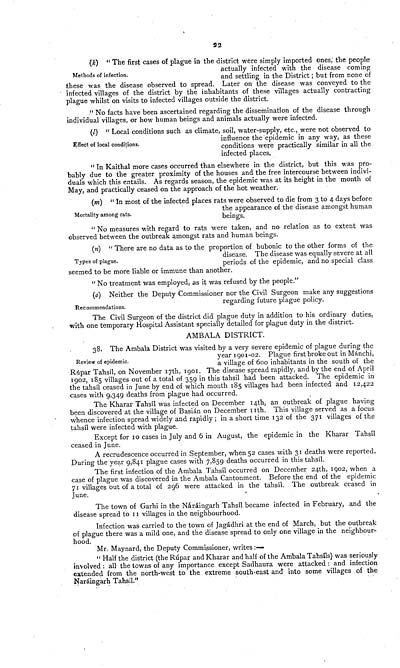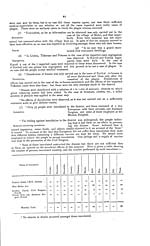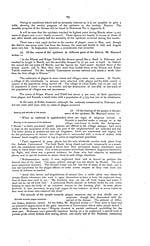Medicine - Disease > Report on plague in the Punjab from October 1st ... to September 30th ..., being the ... season of plague in the province
(36) Page 22
Download files
Individual page:
Thumbnail gallery: Grid view | List view

Methods of infection.
(k) " The first cases of plague in the district were simply imported ones,' the people
actually infected with the disease coming
and settling in the District ; but from none of
these was the disease observed to spread. Later on the disease was conveyed to the
infected villages of the district by the inhabitants of these villages actually contracting
plague whilst on visits to infected villages outside the district.
" No facts have been ascertained regarding the dissemination of the disease through
individual villages, or how human beings and animals actually were infected.
Effect of local conditions.
(l) " Local conditions such as climate, soil, water-supply, etc., were not observed to
influence the epidemic in any way, as these
conditions were practically similar in all the
infected places.
" In Kaithal more cases occurred than elsewhere in the district, but this was pro-
bably due to the greater proximity of the houses and the free intercourse between indivi-
duals which this entails. As regards season, the epidemic was at its height in the month of
May, and practically ceased on the approach of the hot weather.
Mortality among rats.
(m) " In most of the infected places rats were observed to die from 3 to 4 days before
the appearance of the disease amongst human
beings.
" No measures with regard to rats were taken, and no relation as to extent was
observed between the outbreak amongst rats and human beings.
Types of plague.
(n) " There are no data as to the proportion of bubonic to the other forms of the
disease. The disease was equally severe at all
periods of the epidemic, and no special class
seemed to be more liable or immune than another.
" No treatment was employed, as it was refused by the people."
Recommendations.
(0) Neither the Deputy Commissioner nor the Civil Surgeon make any suggestions
regarding future plague policy. Reo ommendations.
The Civil Surgeon of the district did plague duty in addition to his ordinary duties,
with one temporary Hospital Assistant specially detailed for plague duty in the district.
AMBALA DISTRICT.
Review of epidemic.
38. The Ambala District was visited by a very severe epidemic of plague during the
year 1901-02. Plague first broke out in Manchi,
a village of 600 inhabitants in the south of the
Rpar Tahsl, on November 17th, 1901. The disease spread rapidly, and by the end of April
1902, 185 villages out of a total of 359 in this tahsil had been attacked. The epidemic in
the tahsil ceased in June by end of which month 185 villages had been infected and 12,422
cases with 9,349 deaths from plague had occurred.
The Kharar Tahsil was infected on December 14th, an outbreak of plague having
been discovered at the village of Basin on December nth. This village served as a focus
whence infection spread widely and rapidly ; in a short time 132 of the 371 villages of the
tahsil were infected with plague.
Except for 10 cases in July and 6 in August, the epidemic in the Kharar Tahsil
ceased in June.
A recrudescence occurred in September, when 52 cases with 31 deaths were reported.
During the year 9,841 plague cases with 7,859 deaths occurred in this tahsil.
The first infection of the Ambala Tahsil occurred on December 24th, 10,02, when a
case of plague was discovered in the Ambala Cantonment. Before the end of the epidemic
71 villages out of a total of 296 were attacked in the tahsil. The outbreak ceased in
June.
The town of Garhi in the Nringarh Tahsl became infected in February, and the
disease spread to 11 villages in the neighbourhood.
Infection was carried to the town of Jagdhri at the end of March, but the outbreak
of plague there was a mild one, and the disease spread to only one village in the neighbour-
hood.
Mr. Maynard, the Deputy Commissioner, writes:-
" Half the district (the Rpar and Kharar and half of the Ambala Tahsils) was seriously
involved : all the towns of any importance except Sadhaura were attacked : and infection
extended from the north-west to the extreme south-east and into some villages of the
Naringarh Tahsl."
(k) " The first cases of plague in the district were simply imported ones,' the people
actually infected with the disease coming
and settling in the District ; but from none of
these was the disease observed to spread. Later on the disease was conveyed to the
infected villages of the district by the inhabitants of these villages actually contracting
plague whilst on visits to infected villages outside the district.
" No facts have been ascertained regarding the dissemination of the disease through
individual villages, or how human beings and animals actually were infected.
Effect of local conditions.
(l) " Local conditions such as climate, soil, water-supply, etc., were not observed to
influence the epidemic in any way, as these
conditions were practically similar in all the
infected places.
" In Kaithal more cases occurred than elsewhere in the district, but this was pro-
bably due to the greater proximity of the houses and the free intercourse between indivi-
duals which this entails. As regards season, the epidemic was at its height in the month of
May, and practically ceased on the approach of the hot weather.
Mortality among rats.
(m) " In most of the infected places rats were observed to die from 3 to 4 days before
the appearance of the disease amongst human
beings.
" No measures with regard to rats were taken, and no relation as to extent was
observed between the outbreak amongst rats and human beings.
Types of plague.
(n) " There are no data as to the proportion of bubonic to the other forms of the
disease. The disease was equally severe at all
periods of the epidemic, and no special class
seemed to be more liable or immune than another.
" No treatment was employed, as it was refused by the people."
Recommendations.
(0) Neither the Deputy Commissioner nor the Civil Surgeon make any suggestions
regarding future plague policy. Reo ommendations.
The Civil Surgeon of the district did plague duty in addition to his ordinary duties,
with one temporary Hospital Assistant specially detailed for plague duty in the district.
AMBALA DISTRICT.
Review of epidemic.
38. The Ambala District was visited by a very severe epidemic of plague during the
year 1901-02. Plague first broke out in Manchi,
a village of 600 inhabitants in the south of the
Rpar Tahsl, on November 17th, 1901. The disease spread rapidly, and by the end of April
1902, 185 villages out of a total of 359 in this tahsil had been attacked. The epidemic in
the tahsil ceased in June by end of which month 185 villages had been infected and 12,422
cases with 9,349 deaths from plague had occurred.
The Kharar Tahsil was infected on December 14th, an outbreak of plague having
been discovered at the village of Basin on December nth. This village served as a focus
whence infection spread widely and rapidly ; in a short time 132 of the 371 villages of the
tahsil were infected with plague.
Except for 10 cases in July and 6 in August, the epidemic in the Kharar Tahsil
ceased in June.
A recrudescence occurred in September, when 52 cases with 31 deaths were reported.
During the year 9,841 plague cases with 7,859 deaths occurred in this tahsil.
The first infection of the Ambala Tahsil occurred on December 24th, 10,02, when a
case of plague was discovered in the Ambala Cantonment. Before the end of the epidemic
71 villages out of a total of 296 were attacked in the tahsil. The outbreak ceased in
June.
The town of Garhi in the Nringarh Tahsl became infected in February, and the
disease spread to 11 villages in the neighbourhood.
Infection was carried to the town of Jagdhri at the end of March, but the outbreak
of plague there was a mild one, and the disease spread to only one village in the neighbour-
hood.
Mr. Maynard, the Deputy Commissioner, writes:-
" Half the district (the Rpar and Kharar and half of the Ambala Tahsils) was seriously
involved : all the towns of any importance except Sadhaura were attacked : and infection
extended from the north-west to the extreme south-east and into some villages of the
Naringarh Tahsl."
Set display mode to: Large image | Zoom image | Transcription
Images and transcriptions on this page, including medium image downloads, may be used under the Creative Commons Attribution 4.0 International Licence unless otherwise stated. ![]()
| India Papers > Medicine - Disease > Report on plague in the Punjab from October 1st ... to September 30th ..., being the ... season of plague in the province > (36) Page 22 |
|---|
| Permanent URL | https://digital.nls.uk/74579376 |
|---|




